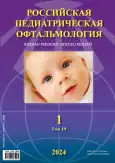Experience in managing patients with X-linked congenital retinoschisis
- Authors: Karyakin M.A.1, Stepanova E.A.1,2, Korotkikh S.A.2, Baksheev I.Y.1, Bolshedvorova A.I.1, Surtaev S.I.1, Shustova A.D.1
-
Affiliations:
- Multiprofile Clinical Medical Center “Bonum”
- Ural State Medical University
- Issue: Vol 19, No 1 (2024)
- Pages: 33-43
- Section: Case reports
- URL: https://bakhtiniada.ru/1993-1859/article/view/254281
- DOI: https://doi.org/10.17816/rpoj568547
- ID: 254281
Cite item
Abstract
AIM: To describe the clinical manifestations and management experience of patients with X-linked congenital retinoschisis (XLRS).
MATERIAL AND METHODS: The study was conducted in the ophthalmology department of the multidisciplinary clinical medical center Bonum (Yekaterinburg). Two brothers with XLRS were under observation. They underwent complete ophthalmological examinations, including electrophysiological examinations, optical coherence tomography (OCT), and fundus photoregistration. The mother refused genetic testing.
RESULTS: Both siblings had early (up to 1 year) manifestations of central foveolamellar and peripheral bullous retinoschisis. The parents are phenotypically healthy, and the relatives have no hereditary eye diseases. The younger brother had a progressive peripheral retinoschisis and underwent barrier laser retinopexy; as a result, the progression stopped at the last examination. Acetazolamide 125 mg given orally daily for 4 weeks did not have a noticeable effect on the volume of bullous cavities. The older brother had been under observation for >4 years, and spontaneous closure of retinal cavities on the periphery in one eye and retinal detachment in the other after surgical treatment of retinoschisis were observed.
CONCLUSION: Clinical cases of long-term follow-up of two brothers with XLRS are described. OCT is indicated to diagnose, assess the length and the state of the vitreoretinal interface, and monitor XLRS. Electroretignography is a specific and sensitive method for the complex diagnosis of XLRS. Barrier laser retinopexy is indicated for progressive peripheral retinoschisis. The efficacy and safety of carbonic anhydrase inhibitors in patients with XLRS require further study.
Full Text
##article.viewOnOriginalSite##About the authors
Mikhail A. Karyakin
Multiprofile Clinical Medical Center “Bonum”
Email: mak1@bk.ru
ORCID iD: 0009-0009-4801-9628
SPIN-code: 9354-7765
MD, Cand. Sci. (Medicine); ophthalmologist
Russian Federation, ЕkaterinburgElena A. Stepanova
Multiprofile Clinical Medical Center “Bonum”; Ural State Medical University
Email: odoc@bonum.info
ORCID iD: 0009-0009-3949-1701
MD, Cand. Sci. (Medicine)
Russian Federation, Еkaterinburg; ЕkaterinburgSergey A. Korotkikh
Ural State Medical University
Email: secretar@mcprof.ru
ORCID iD: 0000-0003-3302-1759
SPIN-code: 7326-7197
MD, Dr. Sci. (Medicine); Professor
Russian Federation, ЕkaterinburgIvan Yu. Baksheev
Multiprofile Clinical Medical Center “Bonum”
Author for correspondence.
Email: inozitol3f@yandex.ru
ORCID iD: 0000-0002-1613-8704
ophthalmologist
Russian Federation, ЕkaterinburgAnastasia I. Bolshedvorova
Multiprofile Clinical Medical Center “Bonum”
Email: odoc@bonum.info
ophthalmologist
Russian Federation, ЕkaterinburgSergey I. Surtaev
Multiprofile Clinical Medical Center “Bonum”
Email: odoc@bonum.info
ophthalmologist
Russian Federation, ЕkaterinburgAlexandra D. Shustova
Multiprofile Clinical Medical Center “Bonum”
Email: odoc@bonum.info
ophthalmologist
Russian Federation, ЕkaterinburgReferences
- Cukras C, Wiley HE, Jeffrey BG, et al. Retinal AAV8-RS1 Gene Therapy for X-Linked Retinoschisis: Initial Findings from a Phase I/ IIa Trial by Intravitreal Delivery. Mol Ther. 2018;26(9):2282–2294. doi: 10.1016/j.ymthe.2018.05.025
- Zhang L, Reyes R, Lee W, et al. Rapid resolution of retinoschisis with acetazolamide. Doc Ophthalmol. 2015;131(1):63–70. doi: 10.1007/s10633-015-9496-8
- Verbakel SK, van de Ven JP, Le Blanc LM, et al. Carbonic Anhydrase Inhibitors for the Treatment of Cystic Macular Lesions in Children With X-Linked Juvenile Retinoschisis. Invest Ophthalmol Vis Sci. 2016;57(13):5143–5147. doi: 10.1167/iovs.16-20078
- Rao P, Dedania VS, Drenser KA. Congenital X-Linked Retinoschisis: An Updated Clinical Review. Asia Pac J Ophthalmol (Phila). 2018;7(3):169–175. doi: 10.22608/APO.201803
- Miyake Y, Shiroyama N, Ota I, Horiguchi M. Focal macular electroretinogram in X-linked congenital retinoschisis. Invest Ophthalmol Vis Sci. 1993;34(3):512–515.
- Mosin IM, Neudakhina EA, Slavinskaya NV, et al. Polymorphism of clinical manifestations of X-linked congenital retinoschisis. Fyodorov Journal of Ophthalmic Surgery. 2009;(2):20–24. (In Russ).
- Marmoy OR, Moinuddin M, Thompson DA. An alternative electroretinography protocol for children: a study of diagnostic agreement and accuracy relative to ISCEV standard electroretinograms. Acta Ophthalmol. 2022;100(3):322–330. doi: 10.1111/aos.14938
- Audo I, Robson AG, Holder GE, Moore AT. The negative ERG: clinical phenotypes and disease mechanisms of inner retinal dysfunction. Surv Ophthalmol. 2008;53(1):16–40. doi: 10.1016/j.survophthal.2007.10.010
- Pimenides D, George ND, Yates JR, et al. X-linked retinoschisis: clinical phenotype and RS1 genotype in 86 UK patients. J Med Genet. 2005;42(6):e35. doi: 10.1136/jmg.2004.029769
Supplementary files

















